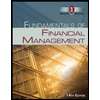Exercise 20-19 (Algo) Schedule of cash payments LO P2 Zisk Company purchases direct materials on credit. Budgeted purchases are April, $89,000; May, $119,000; and June, $129,000. Cash payments for purchases are: 70% in the month of purchase and 30% in the first month after purchase. Purchases for March are $79,000. Prepare a schedule of cash payments for direct materials for April, May, and June. ZISK COMPANY Schedule of Cash Payments for Direct Materials Materials purchases Cash payments for: Total cash payments April May June
Exercise 20-19 (Algo) Schedule of cash payments LO P2 Zisk Company purchases direct materials on credit. Budgeted purchases are April, $89,000; May, $119,000; and June, $129,000. Cash payments for purchases are: 70% in the month of purchase and 30% in the first month after purchase. Purchases for March are $79,000. Prepare a schedule of cash payments for direct materials for April, May, and June. ZISK COMPANY Schedule of Cash Payments for Direct Materials Materials purchases Cash payments for: Total cash payments April May June
Managerial Accounting
15th Edition
ISBN:9781337912020
Author:Carl Warren, Ph.d. Cma William B. Tayler
Publisher:Carl Warren, Ph.d. Cma William B. Tayler
Chapter8: Budgeting
Section: Chapter Questions
Problem 6BE: Cash budget Pasadena Candle Inc. pays 40% of its purchases on account in the month of the purchase...
Related questions
Question
100%

Transcribed Image Text:Exercise 20-19 (Algo) Schedule of cash payments LO P2
Zisk Company purchases direct materials on credit. Budgeted purchases are April, $89,000; May, $119,000; and June, $129,000. Cash
payments for purchases are: 70% in the month of purchase and 30% in the first month after purchase. Purchases for March are
$79,000.
Prepare a schedule of cash payments for direct materials for April, May, and June.
ZISK COMPANY
Schedule of Cash Payments for Direct Materials
Materials purchases
Cash payments for:
Total cash payments
April
May
June
AI-Generated Solution
Unlock instant AI solutions
Tap the button
to generate a solution
Recommended textbooks for you

Managerial Accounting
Accounting
ISBN:
9781337912020
Author:
Carl Warren, Ph.d. Cma William B. Tayler
Publisher:
South-Western College Pub

Managerial Accounting: The Cornerstone of Busines…
Accounting
ISBN:
9781337115773
Author:
Maryanne M. Mowen, Don R. Hansen, Dan L. Heitger
Publisher:
Cengage Learning

Principles of Accounting Volume 2
Accounting
ISBN:
9781947172609
Author:
OpenStax
Publisher:
OpenStax College

Managerial Accounting
Accounting
ISBN:
9781337912020
Author:
Carl Warren, Ph.d. Cma William B. Tayler
Publisher:
South-Western College Pub

Managerial Accounting: The Cornerstone of Busines…
Accounting
ISBN:
9781337115773
Author:
Maryanne M. Mowen, Don R. Hansen, Dan L. Heitger
Publisher:
Cengage Learning

Principles of Accounting Volume 2
Accounting
ISBN:
9781947172609
Author:
OpenStax
Publisher:
OpenStax College

Fundamentals of Financial Management, Concise Edi…
Finance
ISBN:
9781305635937
Author:
Eugene F. Brigham, Joel F. Houston
Publisher:
Cengage Learning

Cornerstones of Financial Accounting
Accounting
ISBN:
9781337690881
Author:
Jay Rich, Jeff Jones
Publisher:
Cengage Learning

Fundamentals of Financial Management (MindTap Cou…
Finance
ISBN:
9781285867977
Author:
Eugene F. Brigham, Joel F. Houston
Publisher:
Cengage Learning